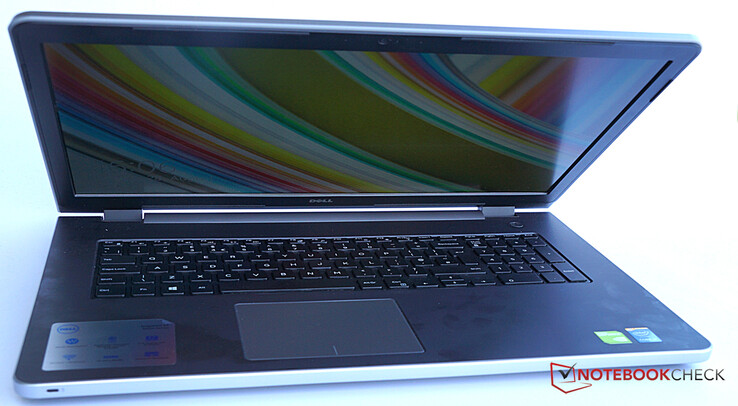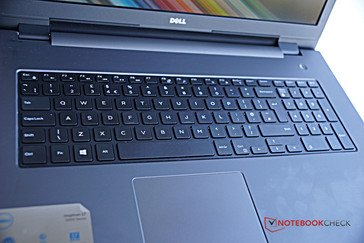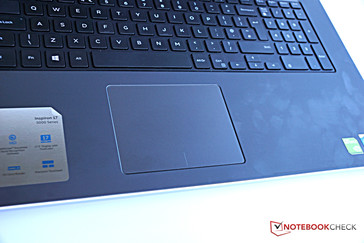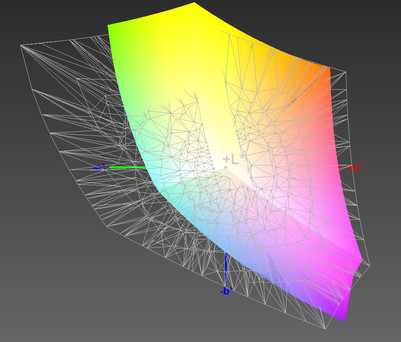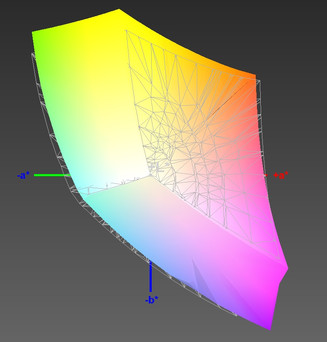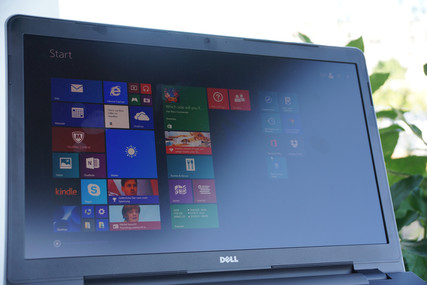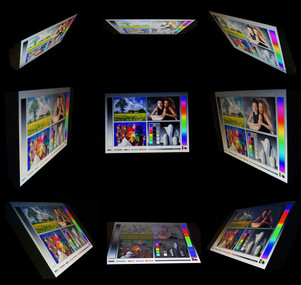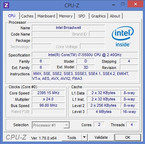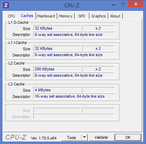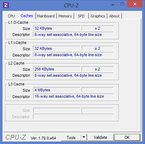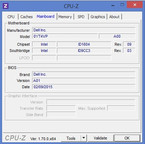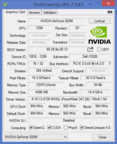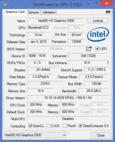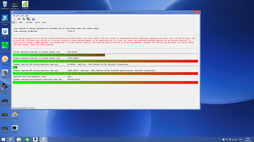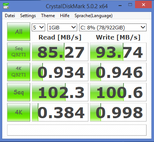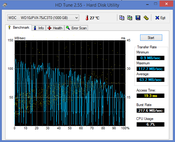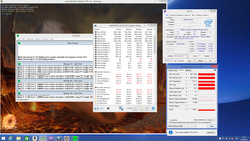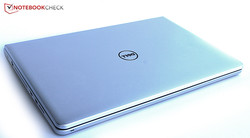Dell Inspiron 17-5758 Notebook Review
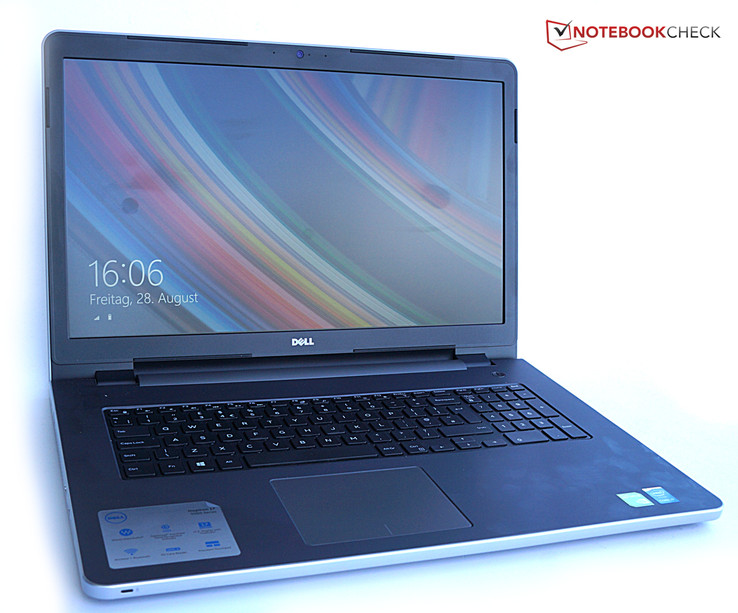
For the original German review, see here.
About one year ago, we had the Dell Inspiron 17-5748 in our test lab. Now, we have the successor under review. Not only the second last number in the name is different, but the Dell Inspiron 17-5758 also comes a revised case, the new generation Intel processor and an optional matte display.
Our test model of the Inspiron 17-5000 series is about 100 Euros (~$111) more expensive than the comparable model from last year without a dedicated graphics card. The cheapest model with an Intel Pentium processor starts from 449 Euros (~$500).
Other large Broadwell notebooks in this price range are the HP Pavilion 17 or the Asus F751LB. For a comparison to the Haswell generation, we have added the Acer TravelMate P276. Like our test model, all notebooks in the comparison group feature a dedicated graphics card.
Case
If you compare the recently reviewed Dell Inspiron 15-5558 with our test model, the case is almost identical apart from the size. The lid of the predecessor was made from metal, but the new Inspiron 17-5000 has a plastic lid with discreet diamond pattern. The liquid crystals become visible when direct pressure is applied to the display. In addition, the large display twists easily.
Now, the Dell Inspiron 17-5758 has a rubberized surface around the keyboard, which feels nice to the touch, but is a magnet for fingerprints. The base unit of the notebook bends quite easily and creaks quietly with side-to-side twisting. The corners can give way slightly when pressure is applied. The keyboard stands out with its contrasting color against the surrounding areas and is slightly lower than the case.
With a maximum height of only 24 mm (~0.94 in), the Dell Inspiron 17-5758 is slightly slimmer than its predecessor. Note: Currently, the size specifications on Dell's German web site are not correct.
Overall, the impression is a mixed bag: We like the used materials, but the stability of the device should be better.
Connectivity
We had criticized the previous Dell Inspiron 17-5000 series because it provided only a few interfaces for a 17.3-inch notebook and this has not changed this year: There are still only two USB 3.0 ports and a USB 2.0 port on the left side. With LAN, HDMI, and card reader, it has the same poor connectivity as its predecessor.
At least, the ports are slightly better spread on the left and right side and plugs no longer get in the way that easily. However, it is annoying that the Dell Inspiron 17-5748 has all of its USB ports towards the front of the sides. Thus, the mouse cable often interferes with the mouse pad when an external mouse is connected. The rear and the front do not house any ports.
Communication
The Dell Insprion 17-5758 lacks a Gigabit LAN module: The maximum transfer rate is 100 MBit. On the other hand, the 17.3-incher of the Inspiron 5000 series supports Wi-Fi standard 802.11ac and you can use the 2.4 GHz as well as the 5 GHz band.
The Wi-Fi reception is still good at a distance of 10 meters (~33 ft) to the router and through three walls. The signal is fully available and web sites open relatively fast.
Accessories
Apart from the laptop, the box contains only a battery, and the power adapter with cable. Many accessories are offered on Dell's web site, however, almost none is specifically for the Inspiron 5000 series. A compatible replacement power adapter costs 75 Euros (~$84) and a suitable knapsack is available for 70 Euros (~$78). A portable energy storage unit for charging on the move is priced at 140 Euros (~$156).
Maintenance
Like the predecessor, the 4-cell battery of our current test model is removable and can be replaced anytime. In order to prolong the lifespan of the battery, you can also run the device without battery. On the underside towards the front, there is a big maintenance hatch, which can be taken off after removing only two screws. Then, you can access the most important components such as the hard drive and RAM.
Warranty
Your PC is protected against damage for 12 months. If this is not sufficient for you, you can extend the warranty: on-site service and premium telephone support are available for a surcharge of just under 70 Euros (~$78). 3 years cost 159 Euros (~$177). If you also want to protect your device against accidental damage for one year, you will have to add an extra 20 Euros (~$22).
Input Devices
Keyboard
The look of the keyboard and the size of its Chiclet keys have remained the same as the predecessor's. The small enter key and the indistinct stroke are still a point of critique.
The typing experience is not as high-end as desired because of a medium key travel and a slightly clattery typing noise. Overall, you can work well with the keyboard.
One further note: Our test model used an English keyboard. Naturally, you will get a German layout by default if you order in a German shop.
Touchpad
The ClickPad is also inherited from the predecessor. It is still minimalist, yet elegantly designed. It can be easily distinguished from the palm rests due to a different material and distinct edges.
The precision of the touch-sensitive surface is impressive, particularly when using multi-touch gestures like "zoom". The keys are integrated in the surface work precisely, and the user receives accurate feedback for every click.
Display
Dell has improved the display: Our test model features a panel from AU Optronics with a native resolution of 1920x1080 pixels and a matte surface. In addition, it uses the IPS technology for wide viewing angles. The predecessor and several of the comparison devices come with TN LED panels, which only allow small deviations from the ideal viewing angle without color distortions.
With 257.5 cd/m², the display is not particularly bright. Thanks to the rather constant brightness distribution of 87%, hardly any brightness difference is visible in large areas. The matte coating is slightly grainy, which is particularly noticeable with white areas.
By the way, the Dell Inspiron 17 is also available with a display resolution of 1600x900 pixels or a glossy Full HD touchscreen.
| |||||||||||||||||||||||||
Brightness Distribution: 87 %
Center on Battery: 328 cd/m²
Contrast: 726:1 (Black: 0.38 cd/m²)
ΔE ColorChecker Calman: 9.38 | ∀{0.5-29.43 Ø4.78}
ΔE Greyscale Calman: 11.81 | ∀{0.09-98 Ø5}
94% sRGB (Argyll 1.6.3 3D)
61% AdobeRGB 1998 (Argyll 1.6.3 3D)
69% AdobeRGB 1998 (Argyll 3D)
94.3% sRGB (Argyll 3D)
69.6% Display P3 (Argyll 3D)
Gamma: 2.03
CCT: 8966 K
| Dell Inspiron 17-5758 GeForce 920M, 5500U, WDC Scorpio Blue WD10JPVX-75JC3T0 | HP Pavilion 17-g013ng GeForce 940M, 5500U, Seagate ST1000LM014 Solid State Hybrid Drive | Asus F751LB-T4030H GeForce 940M, 5500U, Seagate Momentus SpinPoint M8 ST1000LM024 | Acer Travelmate P276-MG-56FU GeForce 840M, 4210U, WDC Scorpio Blue WD10JPVX-22JC3T0 | |
|---|---|---|---|---|
| Screen | 24% | 26% | -2% | |
| Brightness middle (cd/m²) | 276 | 321 16% | 353 28% | 345 25% |
| Brightness (cd/m²) | 258 | 308 19% | 336 30% | 317 23% |
| Brightness Distribution (%) | 87 | 89 2% | 85 -2% | 79 -9% |
| Black Level * (cd/m²) | 0.38 | 0.32 16% | 0.29 24% | 0.55 -45% |
| Contrast (:1) | 726 | 1003 38% | 1217 68% | 627 -14% |
| Colorchecker dE 2000 * | 9.38 | 3.79 60% | 7.03 25% | 10.05 -7% |
| Greyscale dE 2000 * | 11.81 | 4.75 60% | 6.08 49% | 10.18 14% |
| Gamma | 2.03 108% | 2.37 93% | 2.15 102% | 2.72 81% |
| CCT | 8966 72% | 7130 91% | 7457 87% | 12180 53% |
| Color Space (Percent of AdobeRGB 1998) (%) | 61 | 62 2% | 65 7% | 60 -2% |
| Color Space (Percent of sRGB) (%) | 94 | 97 3% | 99 5% |
* ... smaller is better
The black value of the Dell Inspiron 17-5758's display is decent, but the Asus F571 and the HP Pavilion 17 are ahead. Together with the low brightness, our test model achieves a contrast ratio of only 726:1. This is not bad, but not as good as the comparison devices.
Our analysis with the CalMAN software and a spectrophotometer shows bluish gray levels. Most colors are over saturated, especially flesh colors look unnaturally red to the naked eye. Overall, the colors depend strongly on the reference color space, although the display can largely cover the smaller sRGB color space.
Since the Dell Inspiron 17-5758 is large and heavy, it is not ideal for outdoor use. You may want to use your laptop on the balcony or on a journey, anyway and the display is acceptably suited for this: The matte display is a big advantage, since it reduces reflection. However, it is difficult to read from the screen in very bright environments due to the relatively low brightness.
Performance
Dell has now equipped the Inspiron series with the latest generation of Intel processors, Broadwell. Compared to the Haswell predecessors, they are processed in 14 nm and thus more energy efficient and compact.
We checked the latencies (time delays) of the system with the LatencyMon system. If these are too high, audio and video applications and games can stutter. There are actual red spikes, which appear to be caused by the Dell driver "DDDriver.sys", which may be used for system diagnosis. Several forums also suspect that this driver might cause the delays. You can deactivate the driver when you do not need the system diagnoses from Dell and everything should run smoother afterwards.
Processor
A Core i7-5550U dual core processor clocked at 2.4 to 3.0 GHz works in our test model. The "U" in the name hints to an especially frugal model, which can also be used in smaller and more compact notebooks, but works slower than standard volt Core i7 processors.
Depending on the Cinebench version, the differences between our test model and the predecessor with Intel Core i7-4510U vary, but apparently, a real performance gain is only possible in multi core scenarios. The HP Pavilion 17 and the Asus F751 with the same CPU deliver significantly higher performance since their CPU does not throttle that much.
| Cinebench R10 | |
| Rendering Single CPUs 64Bit (sort by value) | |
| Dell Inspiron 17-5758 | |
| Dell Inspiron 17-5748 | |
| Rendering Multiple CPUs 64Bit (sort by value) | |
| Dell Inspiron 17-5758 | |
| Dell Inspiron 17-5748 | |
| Shading 64Bit (sort by value) | |
| Dell Inspiron 17-5758 | |
| Dell Inspiron 17-5748 | |
System Performance
Our current Dell Inspiron 17-5758 test model delivers a better system performance than its predecessor, which is probably due to the dedicated graphics card. Once again, the HP Pavilion 17 and the Asus F751 are ahead.
| PCMark 7 Score | 2846 points | |
| PCMark 8 Home Score Accelerated v2 | 3058 points | |
| PCMark 8 Creative Score Accelerated v2 | 3399 points | |
| PCMark 8 Work Score Accelerated v2 | 3912 points | |
Help | ||
| PCMark 7 - Score (sort by value) | |
| Dell Inspiron 17-5758 | |
| HP Pavilion 17-g013ng | |
| Acer Travelmate P276-MG-56FU | |
| Dell Inspiron 17-5748 | |
| PCMark 8 | |
| Work Score Accelerated v2 (sort by value) | |
| Dell Inspiron 17-5758 | |
| HP Pavilion 17-g013ng | |
| Asus F751LB-T4030H | |
| Acer Travelmate P276-MG-56FU | |
| Dell Inspiron 17-5748 | |
| Creative Score Accelerated v2 (sort by value) | |
| Dell Inspiron 17-5758 | |
| HP Pavilion 17-g013ng | |
| Asus F751LB-T4030H | |
| Acer Travelmate P276-MG-56FU | |
| Dell Inspiron 17-5748 | |
| Home Score Accelerated v2 (sort by value) | |
| Dell Inspiron 17-5758 | |
| HP Pavilion 17-g013ng | |
| Asus F751LB-T4030H | |
| Acer Travelmate P276-MG-56FU | |
| Dell Inspiron 17-5748 | |
Storage Device
In terms of the performance of the storage device, a 1 TB hard drive from Western Digital with 5400 rpm is not one of the strengths of the Dell Inspiron 17-5758. The HD Tune benchmark shows that the transfer rate fluctuates greatly, which is confirmed by CrystalDiskMark.
Graphics Card
The dedicated GeForce 920M is an entry-level graphics card. Although it brings a significant performance gain compared to the processor graphics, it is hardly suitable for gaming with high resolutions. Both, the HP Pavilion 17 and the Asus F751 come with a GeForce 940M, which works even faster.
| 3DMark 11 Performance | 1899 points | |
| 3DMark Ice Storm Standard Score | 41316 points | |
| 3DMark Cloud Gate Standard Score | 5288 points | |
| 3DMark Fire Strike Score | 1028 points | |
Help | ||
| 3DMark 11 | |
| 1280x720 Performance (sort by value) | |
| Dell Inspiron 17-5758 | |
| HP Pavilion 17-g013ng | |
| Asus F751LB-T4030H | |
| Acer Travelmate P276-MG-56FU | |
| Dell Inspiron 17-5748 | |
| 1280x720 Performance GPU (sort by value) | |
| HP Pavilion 17-g013ng | |
| Asus F751LB-T4030H | |
| Acer Travelmate P276-MG-56FU | |
| Dell Inspiron 17-5748 | |
| 1280x720 Performance Physics (sort by value) | |
| HP Pavilion 17-g013ng | |
| Asus F751LB-T4030H | |
| Acer Travelmate P276-MG-56FU | |
| Dell Inspiron 17-5748 | |
| 1280x720 Performance Combined (sort by value) | |
| HP Pavilion 17-g013ng | |
| Asus F751LB-T4030H | |
| Acer Travelmate P276-MG-56FU | |
| Dell Inspiron 17-5748 | |
Gaming Performance
In principle, gaming is possible with the GeForce 920M. However: Only games that are several years old and less demanding like "Diablo III” can run relatively smoothly in native resolution. Even the four years old "Skyrim" only achieves fairly smooth 34 frames per second with medium settings.
Those who only want to play simple games from the Windows app store or browser games should not have any problems. But, even strategy games like "StarCraft II: Heart of the Swarm" bring the graphics card to its limits. Newer and more demanding 3D games are hardly fun and some of these do not even run smoothly with the lowest settings.
| low | med. | high | ultra | |
|---|---|---|---|---|
| The Elder Scrolls V: Skyrim (2011) | 55 | 34.2 | 19.8 | 14 |
| Diablo III (2012) | 110.3 | 69.2 | 55.4 | 36.1 |
| StarCraft II: Heart of the Swarm (2013) | 155 | 72.8 | 32.8 | 12.5 |
| Wolfenstein: The New Order (2014) | 37.1 | 31.1 | 14.2 | |
| Sims 4 (2014) | 175.8 | 73 | 29.8 | 22.7 |
| Fifa 15 (2014) | 68.3 | 52.4 | 33.2 | |
| Middle-earth: Shadow of Mordor (2014) | 29.3 | 18.7 | 9.8 | 5.3 |
| Alien: Isolation (2014) | 44 | 28.1 | 12.3 | 7.1 |
| Far Cry 4 (2014) | 33.1 | 20 | 7.2 | 5 |
| Dragon Age: Inquisition (2014) | 31.6 | 27 | 13.5 | 8.9 |
| The Crew (2014) | 27.1 | 21.1 | 12.3 | 7.2 |
| Evolve (2015) | 24.3 | 17.9 | 8.9 | 7.2 |
| Battlefield Hardline (2015) | 42.2 | 30 | 11.4 | 7 |
| GTA V (2015) | 55.9 | 37.2 | 8.7 | 2.3 |
| Dirt Rally (2015) | 134.2 | 31.1 | 15.9 | 12 |
| The Witcher 3 (2015) | 19.2 | 11.1 | 6.5 | 3.6 |
| Batman: Arkham Knight (2015) | 14 | 11 | 7 | 6 |
Emissions
System Noise
The Dell Inspiron 17-5758 test model is louder than its predecessor and most of the comparison devices. This is partly due to the hard drive, which is very audible with 33.1 dB(A), when you come closer to the device. However, if the load is not too high, the fans remain off. Thus, the system noise is quite comfortable while idling. The DVD drive also works relatively quietly.
Under load the notebook generates up to 45.6 dB(A), which is very audible and clearly louder than the comparison devices. Only, the HP Pavilion 17 can get even louder. At least, the fan noise is still comfortable, but the frequency of the noise should definitely not be higher.
Noise level
| Idle |
| 31.6 / 31.6 / 32.9 dB(A) |
| HDD |
| 33.1 dB(A) |
| DVD |
| 36.2 / dB(A) |
| Load |
| 45.4 / 45.6 dB(A) |
 | ||
30 dB silent 40 dB(A) audible 50 dB(A) loud |
||
min: | ||
Temperature
Under load, we measured a very high temperature of up to 54.1 °C (~129 °F) in the upper left area of the keyboard, i.e. around the Escape key! This is definitely too high, even though it is limited to a small spot. Fortunately, the underside remains cooler and the palm rest is always comfortably cool.
While idling, the case gets only slightly warm, particularly in the right front area, which is exactly opposite to the hot spot under load. However, the heating is significantly less noticeable.
During our stress test, graphics card and processor are stressed for a longer time. After a while, the processor just reaches clock rates of 2 GHz. However, the clock rate is also not higher without active graphics card. Thus, throttling is not caused by simultaneous use of GPU and CPU in this case. The reason is more likely to be that the CPU already reaches temperatures of about 100 °C (~212 °F) after a short time, which is too hot for permanent use and could decrease the lifespan. The GeForce 920M can work at its maximum clock for the whole time and with 75 °C (~167 °F), does also not get too hot.
(-) The maximum temperature on the upper side is 54.1 °C / 129 F, compared to the average of 36.9 °C / 98 F, ranging from 21.1 to 71 °C for the class Multimedia.
(±) The bottom heats up to a maximum of 43 °C / 109 F, compared to the average of 39.2 °C / 103 F
(+) In idle usage, the average temperature for the upper side is 29.7 °C / 85 F, compared to the device average of 31.3 °C / 88 F.
(+) The palmrests and touchpad are reaching skin temperature as a maximum (33.3 °C / 91.9 F) and are therefore not hot.
(-) The average temperature of the palmrest area of similar devices was 28.7 °C / 83.7 F (-4.6 °C / -8.2 F).
Speakers
The speakers sit below the front edge and deliver an acceptable sound. Even bass is noticeable. The maximum volume is good, but the sound is rather crackled and distorted at maximum volume, especially low tones. The sound is slightly dull in general, but the speakers can be used for occasional videos or songs. You will get clear sound without distortions via headphones and 3.5 mm jack.
Energy Management
Power Consumption
The energy consumption is slightly higher than the predecessor's while idling. Nevertheless, the Dell Inspiron 17-5758 performs well in this respect. You should consider that unlike the predecessor, our test model has a dedicated graphics card and that the Inspiron 17-5758's energy demand is very low compared to other devices.
The maximum of 40.8 watts is by far the lowest among the comparison devices. For example, the HP Pavilion 17 requires above 61 watts. However, you should remember that our test model cannot use its full CPU potential due to throttling. The idle consumption is significantly lower than those of the HP Pavilion 17, the Acer TravelMate P276 or the Asus F571LB.
| Off / Standby | |
| Idle | |
| Load |
|
Key:
min: | |
| Dell Inspiron 17-5758 GeForce 920M, 5500U, WDC Scorpio Blue WD10JPVX-75JC3T0 | HP Pavilion 17-g013ng GeForce 940M, 5500U, Seagate ST1000LM014 Solid State Hybrid Drive | Asus F751LB-T4030H GeForce 940M, 5500U, Seagate Momentus SpinPoint M8 ST1000LM024 | Acer Travelmate P276-MG-56FU GeForce 840M, 4210U, WDC Scorpio Blue WD10JPVX-22JC3T0 | Dell Inspiron 17-5748 HD Graphics 4400, 4510U, Samsung SpinPoint M8 HN-M101MBB | |
|---|---|---|---|---|---|
| Power Consumption | -27% | -18% | -35% | 6% | |
| Idle Minimum * (Watt) | 4 | 5.3 -33% | 3.9 2% | 6.7 -68% | 3.8 5% |
| Idle Average * (Watt) | 9.2 | 10 -9% | 11.6 -26% | 11.8 -28% | 8.6 7% |
| Idle Maximum * (Watt) | 9.4 | 10.8 -15% | 12.2 -30% | 12.3 -31% | 9.8 -4% |
| Load Average * (Watt) | 40.4 | 51.7 -28% | 41.3 -2% | 46.8 -16% | 28.2 30% |
| Load Maximum * (Watt) | 40.8 | 61.6 -51% | 55.6 -36% | 53.5 -31% | 44.1 -8% |
* ... smaller is better
Battery Life
The battery life of the Dell Inspiron 17-5758 is roughly on par with the predecessor's. The slightly shorter Wi-Fi runtime is due to our new Wi-Fi test, which uses modern Internet technology and is, thus, more demanding.
The idle runtime of the HP Pavilion 17 or the Acer TravelMate P276 is significantly longer: Our test model shuts down after 7:28 hours.
Overall, the Dell Inspiron 17-5758 achieves quite passable battery runtimes with its 40 Wh battery, even more so, in view of the fact that 17-inch notebooks are mostly used in a fixed place.
| Dell Inspiron 17-5758 GeForce 920M, 5500U, WDC Scorpio Blue WD10JPVX-75JC3T0 | HP Pavilion 17-g013ng GeForce 940M, 5500U, Seagate ST1000LM014 Solid State Hybrid Drive | Asus F751LB-T4030H GeForce 940M, 5500U, Seagate Momentus SpinPoint M8 ST1000LM024 | Acer Travelmate P276-MG-56FU GeForce 840M, 4210U, WDC Scorpio Blue WD10JPVX-22JC3T0 | Dell Inspiron 17-5748 HD Graphics 4400, 4510U, Samsung SpinPoint M8 HN-M101MBB | |
|---|---|---|---|---|---|
| Battery runtime | 5% | -5% | 12% | -2% | |
| Reader / Idle (h) | 7.5 | 10.3 37% | 9.7 29% | 7.7 3% | |
| WiFi v1.3 (h) | 4.1 | 4.4 7% | 3.9 -5% | ||
| Load (h) | 1.8 | 1.3 -28% | 1.7 -6% | 1.7 -6% | |
| WiFi (h) | 4.6 | 5 |
Pros
Cons
Verdict
The predecessor was good. The Dell Inspiron 17-5758 is only a small update, and many of our points of critique remained unchanged: There are still only a few interfaces, which are unfavorably placed, but at least they are no longer too close to each other. Gigabit LAN is missing and the warranty ends after 12 months. We miss the metal lid of the predecessor, since it was elegant and ensured a slightly better stability of the case. Thus, the chassis of the Dell Inspiron 17-5758 appears only modest.
The device is too loud under load and the dedicated graphics card is hardly suitable for current games. Under full load, the device gets too hot on the upper side. Thus, the processor throttles under full load.
However, we liked the matte IPS display, which should be brighter and have more accurate colors. The ClickPad impresses with its high precision, and the power consumption is pleasingly low. In addition, the Wi-Fi reception is flawless this time and is now supporting the 802.11ac Wi-Fi standard. The GeForce 920M even offers basic gaming capabilities.
Thus, the Dell Inspiron 17-5758 is a mixed bag. Although the predecessor had drawbacks, it appeared more balanced. Other multimedia notebooks offer significantly more for the same price.
Dell Inspiron 17-5758
- 08/28/2015 v4 (old)
Florian Wimmer




